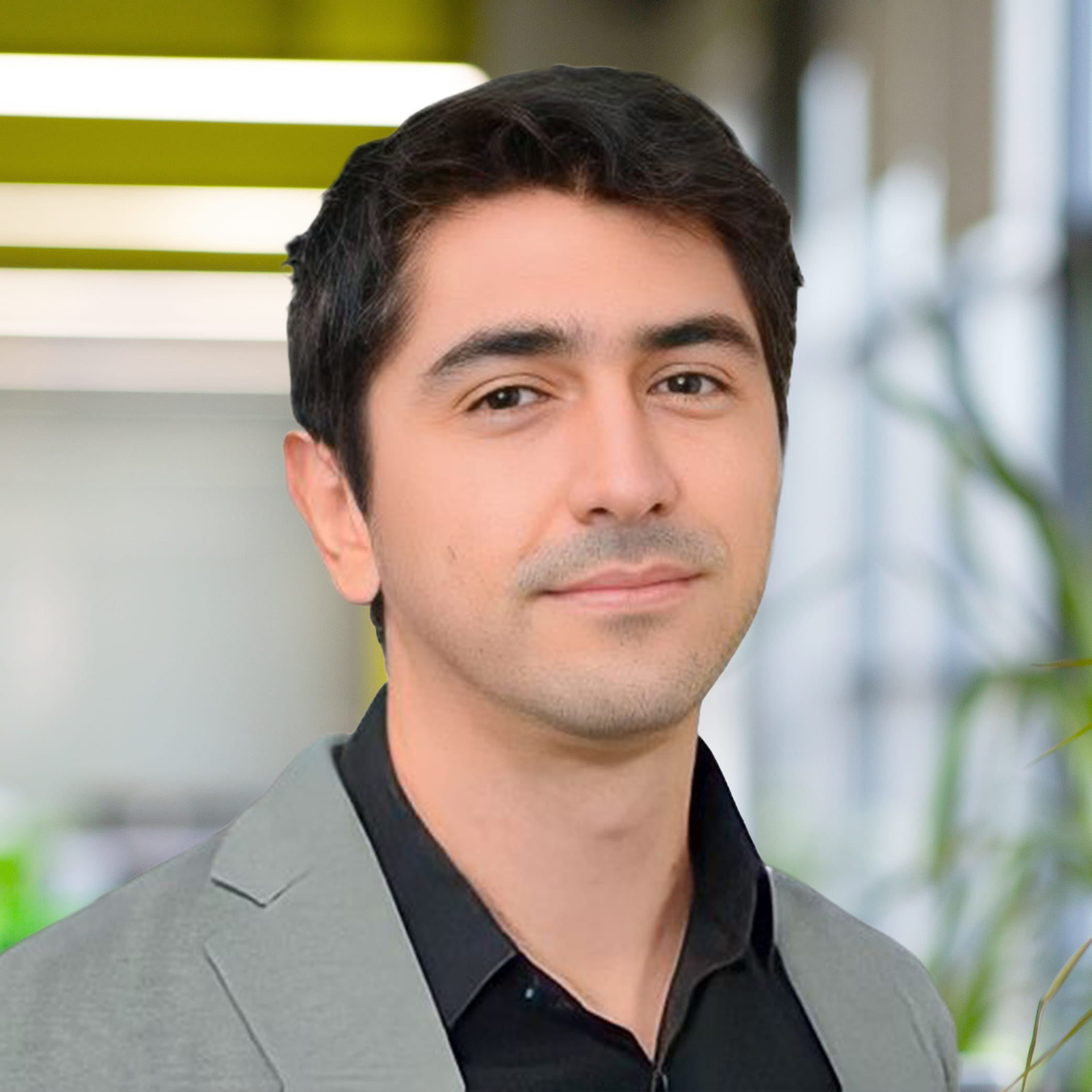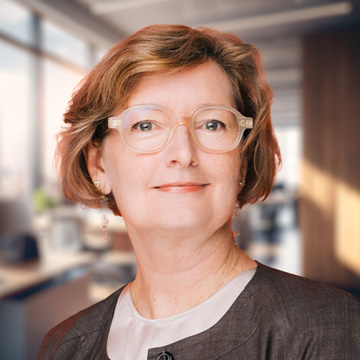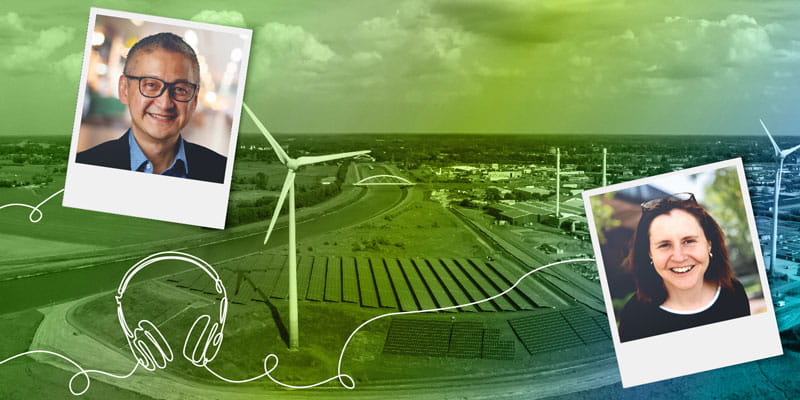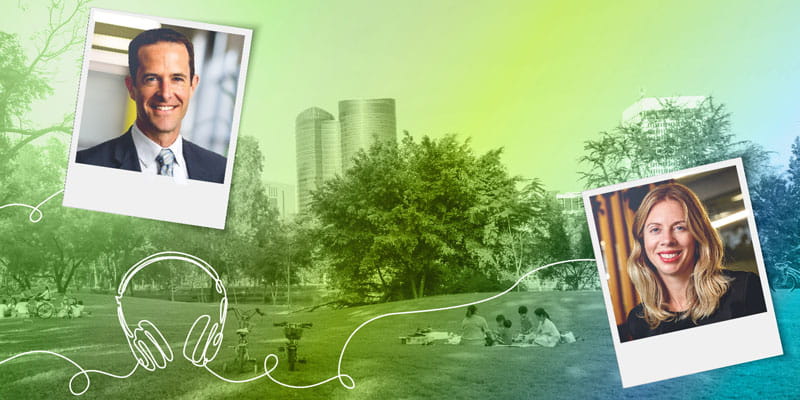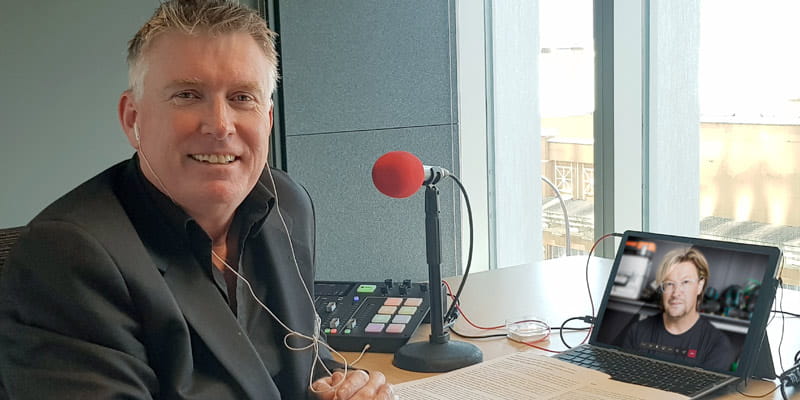Maria Rampa: Hi, I’m Maria Rampa and welcome to this episode of Engineering Reimagined.
Take a look around your home or workplace: how many smart devices make your life and work more efficient?
There’s smart washers that can text you when the laundry is complete; fridges that keep a tally of expiry dates; virtual meeting facilities that seamlessly connect you to peers around the world; and voice-activated technology to help you communicate and interact with your environment more effectively.
Each of these have been designed to create the smart, accessible and inclusive homes, workplaces and lifestyle facilities we take for granted today.
But all these advancements in technology use a lot of energy and don’t necessarily consider our overall health and wellbeing.
So, concurrently, we need to be designing homes, workplaces and public buildings that reduce our carbon footprint and are healthier and more supportive of the end-user experience.
How can we re-engineer buildings to create not just smarter, but more sustainable, energy efficient and comfortable structures that are also resilient to the impacts of climate change?
One answer is Passivhaus – a voluntary standard for design and construction that provides a template for ultra–low energy buildings that support high levels of occupant comfort, energy efficiency and resilience to future climate change impacts.
In this episode of Engineering Reimagined, Aurecon's Associate, Sustainability & Integrated Design, and certified Passivhaus designer, Pablo Sepulveda, speaks to Architect and founder of the North American Passive House Network, Bronwyn Barry, about how and why she is a champion of Passivhaus, the impact it’s having on global design and the challenges it faces in becoming an industry standard around the world.
+++++
Pablo Sepulveda: Hi, Bronwyn. Welcome to the podcast.
Bronwyn Barry: Hey there. Looking forward to being on the Aurecon podcast.
Pablo Sepulveda: It's very exciting to have you here. The last time we saw each other face to face was 2019. It was in a metro in Beijing. It was the Passivhaus conference. And always looking what are you doing and how you are being a champion in Passivhaus and advocating for it.
Bronwyn Barry: Thank you, Pablo. The Aussies and the Kiwis are really championing Passivhaus in a way that's super exciting for me to watch.
Pablo Sepulveda: You are an architect by profession like me. And so, what inspired you to specialise in sustainability and high-performance building design?
Bronwyn Barry: Really, I started many years ago. I came here to California to do my architecture training and right from the get go, was really looking for how do we do buildings that are much more healthy and supportive for human occupation? And that was the time when green building was really just emerging as a concept. As an architect, we don't really have an equivalent of the Hippocratic Oath that doctors have. But we do have a standard of care. And that always really struck me, like, how can I, as an architect, responsible for designing buildings that people are going to supposedly live in for, and occupy, for 50 to 100 years and hopefully even longer. And that's really where my journey first started towards, trying to define what is a green building, what's a sustainable building. And in the early days, that really was very nebulous. Nobody really had a real defined idea of what that meant. It's still evolving in many ways. Right?
Pablo Sepulveda: Yeah, that's right. So, for all this certification, you have in the US, LEED and here in Australia, Green star and international ones like, WELL. So what is Passivhaus and how does it compare to all these certifications? People get a little bit overwhelmed with all these labels.
Bronwyn Barry: Each of these frameworks has attempted to answer that question and provide a guide and a framework for how to build a green building. What drew me to Passivhaus particularly was it wasn't a checklist, but it had these three things. It had clear targets, it had tools that allowed you to determine whether you met the targets, and it has training. So a support like framework for how to teach architects like me, who really weren't trained in energy modelling or any of this analysis for defining outcomes for buildings. As I started to practice and look for outcomes that I could reliably lean on to ensure that everything that I designed actually worked well, was comfortable and performed well for the occupants. I was missing the tools, I was missing the targets, and I was definitely missing the training. That's exactly what Passivhaus provided. And it was in this Green Remodelers Guild community that I had helped start here in the Bay Area, that a guy showed up. He'd married an Austrian woman, gone and lived in Austria for a while. learned about Passivhaus himself and he and his wife came back to California, and they renovated a house here in Berkeley and they used this thing called Passivhaus and told us the story about what it is. It was such a light bulb moment because it really was all the things I had been looking for, it had a reliable outcomes process that every building I designed from then on, if I use this methodology, I use the tool, aim for the targets, I pretty much can guarantee that it was going to perform and be comfortable. And that to me is the magic of Passivhaus.
Pablo Sepulveda: It's no surprise. All the feedback you have from client afterwards, you know, that will be positive and you are actually looking forward to hear them because you know what? It will happen. Everyone that has done the Passivhaus training to be a certified Passivhaus designer is a highlight in the careers. Engineers are like, oh, now I see things differently. I see things more holistically. And architects struggle with numbers and calculation. They said like, oh my God, it was so tough. But now I have a power to know what I'm doing and what is the consequences of my design. So, it's very empowering for engineers and architects. Can you tell us about the five Passivhaus principles and how they work together? Because that's an important point to people to understand.
Bronwyn Barry: It's a very simple recipe. Five real basics, starting with super insulation. And usually that's just a little bit better than what your baseline code requires. Better windows, so sometimes double or most often triple, but depending on your climate, but just better windows than baseline code. And then it's heat recovery or energy recovery, ventilation. So really guaranteeing that you're getting actual fresh air and not just random air from random places. Then it's no thermal bridges. Just making sure that you haven't punctured holes in your beautiful insulation that transfer the heat in or out of your building. And then the last thing is air tightness, which, by the way, I'm starting to translate as smoke tightness for our California and I bet your Australian context because we share very unfortunate frequency of wildfires. It's making that airtightness requirement very relevant in a very different way. This is something I've found, all those Passivhaus principles are becoming more and more relevant and critical as we face pretty severe climate change impacts. And they're upon us already. They're not a future scenario.
Pablo Sepulveda: Passivhaus started like a very niche thing. Now, if you see what is going on today in terms of climate change, energy cost, and Passivhaus can answer those questions in a very scientific way. Up to 90% of less energy for heating and cooling if you compare it with the national code. Why do you think that Passivhaus hasn't been commonplace by now?
Bronwyn Barry: I've asked myself that question for many years and we started going down the policy rabbit hole and really kind of digging into why isn't Passivhaus just everywhere? And the more I engaged in policy and trying to insert Passivhaus into the conventional code structures, the more I found that they totally don't connect. When we analysed how code structures work, they're a linear incrementalist process and they're built that way. If we try and plug in airtightness into baseline code, but we cannot simultaneously guarantee that a heat recovery or energy recovery ventilation system will also be required, we're potentially creating a building science disaster.
Pablo Sepulveda: Yes. Because they work together. So, you cannot pick and choose and say, like we are going to do this and not going to do that.
Bronwyn Barry: Exactly. Passivhaus is a circular structure, it's all connected, you change one thing and it affects every other thing. You can't do Passivhaus as a piecemeal, a la carte menu. It's something that is a prefix, it's a full menu, integrated and it's all connected. And so why Passivhaus isn't sort of more ubiquitous is, we live still in a linear incrementalist policy world. Our policy doesn't have really great mechanisms to integrate holistic circular building design approaches. And just until recently, I really struggled with, how do we reconcile these two completely conflicting structures? And we come to this new realisation that they don't have to be integrated, but the holistic integrated process like Passivhaus can actually accelerate the linear incrementalist baseline code structures by working in parallel. And so this sort of parallel pathway is now, in the policy world, being adopted really well in some jurisdictions. And they're seeing that much more Passivhaus buildings are being built.
Pablo Sepulveda: I'm following what is going on in New Zealand. They are going to incrementally change the building code. Every five years there will be an upgrade of that. And they are aiming to basically ask an equivalent of a Passivhaus by 2035. It will be very interesting to see how that develops, how the industry adapts, and there have to be a lot of changes, but they are doing it in that incremental way.
Bronwyn Barry: That's what's worked so well in Vancouver and in British Columbia. They did the same thing with their BC step code where they said we know you're not there yet, but this is where we're going. And the end goal is equivalent to Passivhaus.
Pablo Sepulveda: Passivhaus was originated in Europe and the first project that I was working on here in Australia was a Passivhaus building. And the first reaction of people is like, why you are doing Passivhaus in Australia? It's not the climate for that. Can you bust this myth that Passivhaus is only for cold climates?
Bronwyn Barry: Absolutely. And I sympathise because I've had exactly the same challenge here in California. Everybody had exactly the same response. Well, Passivhaus is only for cold climates. And after almost 15 years now working here in California, designing only passivhaus all the data is showing very clearly that actually, it works fantastically in our Mediterranean climate. And in fact, it's working much better than all the baseline code stuff. And I can very comfortably say it absolutely works in warm climates.
Pablo Sepulveda: What do you think it requires to make Passivhaus more acceptable for developers, owners, designers and builders?
Bronwyn Barry: So the only barrier I found to Passivhaus is actually education and a mindset of people because we are now also starting to integrate embodied carbon analysis with our operational carbon analysis. The Passivhaus network has worked with the ACB, our UK colleagues, and we commissioned them to make an adaptation of the PH ribbon embodied carbon calculator plugin. And I've been doing this on a couple of my projects, so we can do operational and embodied carbon calculation in the same tool. And what I'm finding is actually our Passivhaus projects are not higher embodied carbon than baseline code. And in fact, it's really just a function of what materials you pick. And the increased insulation is a total red herring. Because what we have found in this analysis, once you really do the math, actually the size of your PV array can completely shift your embodied carbon footprint and can be much higher embodied carbon than any of your insulation or even your glazing increase.
Pablo Sepulveda: Right.
Bronwyn Barry: So, to the extent that your Passivhaus envelope can decrease the generation requirement, the demand, of onsite energy, you can massively offset your embodied carbon footprint by just needing a smaller PV array.
Pablo Sepulveda: So, can you tell us a little bit about some examples you have seen around the world?
Bronwyn Barry: I was in Vienna when they gave the certification for the first, the Robins Bank Building. It was a retrofit of an old building with a new building in between. It was the first Passivhaus, it was a tall building and it was an all-glass office tower. And that was fascinating because it's not a house.
Pablo Sepulveda: And it's a retrofit, which is very difficult. Working with the constraint of an existing building is way more difficult to do. So it’s very impressive.
Bronwyn Barry: Yeah. And the beautiful thing about that particular building, it was built as the OPEC oil building in Vienna that was revamped and rebuilt as a Passivhaus by this bank. And so it was a beautiful transformation, both physically and metaphorically, from old tech oil-based fossil fuel system to the new way of building that is really super hopeful and representative of exactly what we need to be doing with how we address our built environment. Another building I went to, you may have gone to too, in China at the Expo. It was essentially a Passivhaus museum.
Pablo Sepulveda: Yes.
Bronwyn Barry: And the whole building was filled with different exhibits of the Passivhaus principles. And the museum had these fabulous displays that illustrated or demonstrated what those were, and you could play around with them, and they were interactive. And it was also just a beautiful building.
Pablo Sepulveda: That was a fun building. It was quite impressive to see what they are doing in China. Can you tell us a little bit about what is like to live or work in a Passivhaus building?
Bronwyn Barry: So I have to, true confessions. I still do not live in a Passivhaus building myself, which I hope to remedy that pretty soon. But from all the client feedback that I get from projects I have designed, what people over and over tell me is everything just is super quiet and peaceful, and it's something that they come to realise when they leave their houses, that every other building compared to theirs is just noisy. It's something that we in the Passivhaus community don't necessarily talk about and promote. We talk about health, comfort, but we don't talk about quiet. And it's like this hidden superpower.
Pablo Sepulveda: Yeah. And it has a very big impact in your mental health.
Bronwyn Barry: On one of our Passivhaus network conferences, we did a tour of buildings in New York City. And one of the projects we went to in Brooklyn, it was on a noisy street, there's always sirens in New York. But as soon as the group got into the house, the tour guide shut the door and he said, just stop for a minute and listen. And it was quiet, and it was exactly that peace of mind where you suddenly could just relax mentally because there was none of this crazy outside noise that we just assume and it becomes so ubiquitous and we just literally tune it out. But when we don't have to tune it out, it's this amazing magic space and it's a gift that we really need to give ourselves more often.
Pablo Sepulveda: I would like to talk a little bit about the future. The emerging technologies that can change the way we design, construct and maintain our buildings to create a more sustainable future.
Bronwyn Barry: Our industry is becoming a lot better at integrating multiple analyses of what we do to buildings. The innovation in Passivhaus has really been in not so much the tech gizmos in the building, but in the holistic technical analysis of the building design, learning what matters in this analysis and how to apply that into buildings. We've got BIM modelling. We can now export a lot of the information in that into our energy model. Aurecon are doing an incredible job of being able to synthesise all of these different modelling tools to create better outcomes. That's a huge innovation. We are integrating cross laminated timber, we're integrating prefab panelisation into our building methodologies. That's the tech that I'm the most excited about is this ability to properly analyse and predict outcomes and to synthesise both the design with the construction and the modelling.
Pablo Sepulveda: I saw that you represented the Passivhaus network at COP27. What should we - as an architecture, engineering, construction industry - focus in the next decade of climate action?
Bronwyn Barry: The thing we should really be focusing on right now is peak heating and peak cooling. Those are the numbers that matter. Everything else seems to be just a side outcome. I look at people and they're aiming at net zero. But it doesn't focus on the peaks and unless you drive those down, those are what are going to enable a renewable energy system to function and to be viable. So as architects and designers, those are the numbers that seem to matter. It makes a renewable grid actually sustainable and that's really where we have to get to. But what I see over and over again, that also will change all our materials, embodied carbon numbers will change depending on where those materials are manufactured and how they are manufactured. So being very careful about what products we specify now, because those embodied carbon numbers are fixed to our current emissions data. And ironically, the last thing I'll add to this is, and this is something I learned from Diana Ürge-Vorsatz, who was the lead author for the building section of the IPCC report. One of the things they saw in the analysis of carbon emissions is sometimes doing nothing specifically for retrofits is potentially the better thing to do than to do an incremental retrofit that locks in the emissions for a building that won't allow a much deeper, more effective retrofit at a later date.
Pablo Sepulveda: I have seen that trend in Europe in terms of retrofit. I know some architects that, as a statement, they said that they are refusing to do new buildings altogether. It is just interesting to see how that's shifting very quickly as a way of combating climate change.
Bronwyn Barry: I would be hesitant to make that kind of statement because if you're only doing an incremental retrofit, you're possibly doing actually a worse job than not doing it or leaving it until later, when these smarter systems, better products, higher efficiencies you can get from a retrofit at a later date.
Pablo Sepulveda: That's when the data and calculation and those tools can tell you, because just basing your statement in something that you believe is very different than to calculate and then say like, no, this is it. Absolutely.
Bronwyn Barry: That's one thing that in all this that I've learned is, you have to park your assumptions at the back of the room, exactly. Because guaranteed, many of those things that you sort of intuitively think should be how it is when you do the calculations, you're like, oh no, the actual data can often tell you quite a different story. And that's been a real revelation.
Pablo Sepulveda: Especially when you think about, that you have all these climates and you have all these different industries that have different embodied carbon levels. If you do not do the local math, you are going to be assuming things that could be true for other regions but not for your own one. So that's very important. I think sustainability is very contextual.
Bronwyn Barry: I think that's a great way to put it, Pablo.
Pablo Sepulveda: Bronwyn, thank you very much. I really enjoyed talking with you and having your insight. So thank you for joining us in this Aurecon podcast.
Bronwyn Barry: Thank you, Pablo. It's been an absolute pleasure and I look forward to watching and seeing more fantastic projects that you have been working on. So, thanks again for having me.
+++++
Maria Rampa: We hope you enjoyed this episode of Engineering Reimagined.
As this concept continues to spread around the globe, can you imagine the positive impact on climate change if all buildings adopted the Passivhaus standard?
If you enjoyed this episode, hit subscribe on Apple, Google Podcasts or Spotify and don’t forget to follow Aurecon on your favourite social media platform to stay up to date and join the conversation.
Until next time, thanks for listening.







